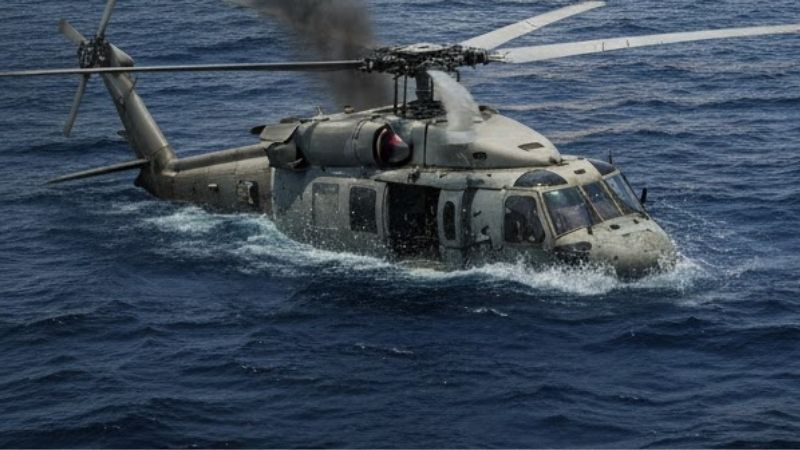Two US Navy Aircraft Crash in South China Sea Highlight Rising Electromagnetic Threats
Date: October 27, 2025
Location: South China Sea
Overview of US Navy Jet and Helicopter Crash in South China Sea : In a rare occurrence, a US Navy MH-60R Seahawk helicopter and an F/A-18F Super Hornet fighter jet crashed into the South China Sea on Sunday, within 30 minutes of each other. Remarkably, all five crew members were rescued safely.
Details of US Navy Jet and Helicopter Crash in South China Sea
- The MH-60R Seahawk helicopter went down first at around 2:45 p.m. local time while conducting routine operations from the USS Nimitz. Its three crew members were rescued by search-and-rescue teams.
- About 30 minutes later, the F/A-18F Super Hornet fighter jet crashed, with both crew members ejecting safely and being recovered without injuries.
- The Navy confirmed that the causes of both crashes are under investigation, and no fatalities occurred.
Must Read: Twitch CEO Apologizes After Emiru’s Assault Sparks Security Crisis and Mizkif Allegations
USS Nimitz: Background
- The USS Nimitz is one of the largest and oldest aircraft carriers in the US Navy, currently on its final deployment before decommissioning.
- Recently, it has been deployed to the Middle East as part of the US response to attacks by Yemen’s Houthi rebels on commercial shipping.
- The carrier is returning to its home port at Naval Base Kitsap, Washington.
Strategic Importance of the South China Sea
- The South China Sea is a strategically vital waterway, heavily contested by China, Taiwan, Vietnam, the Philippines, Malaysia, and Brunei.
- China claims almost the entire region and has fortified outposts on disputed islands, building several artificial islands for military purposes.
- The US maintains a steady naval presence in the region to ensure freedom of navigation and support allies, which sometimes leads to tensions with Beijing.
Past Aircraft Mishaps in the US Navy
- The F/A-18F Super Hornet is the fourth fighter jet lost by the Navy this year, costing around $60 million per aircraft.
- Earlier mishaps include:
- Two F/A-18 jets lost from the USS Harry S. Truman in the Red Sea.
- One jet shot down by accident from the guided-missile cruiser USS Gettysburg.
- Another F/A-18 falling off a carrier’s hangar deck due to landing system issues.
No sailors were killed in these previous incidents, though investigations are ongoing.
US Leadership Response
President Donald Trump, speaking aboard Air Force One, described the incidents as “very unusual” and suggested a possible fuel issue.
Trump emphasized that investigations will reveal the cause, stating, “We’re gonna find out. Nothing to hide, sir.”
These incidents occurred amid Trump’s diplomatic tour in Asia, including upcoming meetings with Chinese leader Xi Jinping focused on trade discussions.
Why This Matters
- The back-to-back crashes highlight operational risks for US Navy aircraft in critical and contested regions.
- They also underscore the importance of naval presence in the South China Sea, where tensions between the US and China remain high.
- While no lives were lost, the incidents serve as a reminder of the high costs and challenges of military operations in strategically sensitive areas.
Key Takeaways
Both the helicopter and fighter jet crashes occurred within 30 minutes of each other, yet all crew members were rescued.
USS Nimitz, the oldest US aircraft carrier in service, is returning home after a summer deployment.
The South China Sea remains a hotspot for geopolitical tensions and naval operations.
Investigations are ongoing, with speculation about fuel issues or mechanical failures.
These incidents are part of a series of recent aircraft mishaps in the US Navy, but no fatalities have occurred.
Possible Electronic Interference
While investigations are ongoing, experts point to China’s extensive electronic warfare infrastructure across the South China Sea as a potential contributing factor. China has deployed a sophisticated network of long-range surveillance radars, shore-based jamming arrays, portable emitters, and frequency agile signal nodes on its man-made islands and outposts.
These systems are designed to detect, geolocate, and interfere with a wide range of signals, including GPS, tactical data links, maritime communications, and airborne sensor feeds. Overlapping coverage zones create localized electromagnetic “hotspots”, where temporary signal disruptions can mimic internal aircraft failures, making it challenging to distinguish between technical malfunctions and deliberate interference.
Risks to Carrier-Based Operations
Carrier-based aircraft operating at low altitude or performing precision approaches are particularly vulnerable. Brief disruptions to navigation or data links can cause cascading avionics anomalies, forcing pilots to rely on manual control under highly constrained conditions. Jamming signals can also create false radar readings, potentially giving crews conflicting target information at critical moments.
The People’s Liberation Army (PLA) has integrated such electronic measures into broader area-denial strategies. Radar and electronic intelligence nodes on the Spratly outposts are linked to higher-echelon coastal defense systems, allowing China to adjust emission patterns quickly to counter perceived threats.
Implications for US Naval Operations
If investigations confirm that electronic interference contributed to the crashes, this incident could escalate from a tragic accident to a major geopolitical flashpoint. The US and allied forces may respond by:
- Deploying hardened electronic warfare countermeasures on carrier strike groups.
- Conducting spectrum denial drills to counter hostile signals.
- Reclassifying Chinese outposts as active threat emitters rather than passive surveillance nodes.
Pilot reports of instrument anomalies will be cross-referenced with signals intelligence to determine whether the failures were internal or externally induced.
Strategic Impact on China
China’s doctrine in the South China Sea relies heavily on non-kinetic control and plausible deniability. Should investigations reveal deliberate interference, China would lose the ambiguity that allows it to escalate tensions without attribution. This could force Beijing to either intensify covert electronic operations or adjust its deterrence strategy to avoid crossing kinetic thresholds.
Experts warn that the incident could reshape the operational posture of the US and its allies in the region, leading to heightened tensions and increased readiness against potential electronic threats.
Final Thought
The crashes of the Seahawk and Super Hornet underscore the growing vulnerability of modern military aircraft to sophisticated electronic warfare. With strategic stakes high in the South China Sea, both the US and China are expected to closely monitor the unfolding investigations, with significant implications for regional security, naval operations, and international relations.







